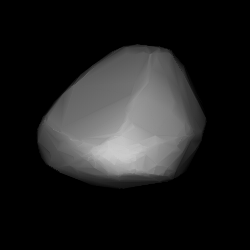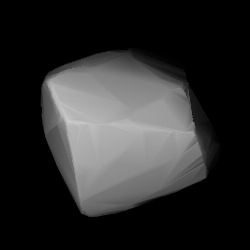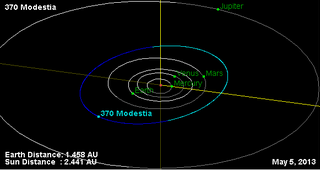
Vincentina is a fairly large main belt asteroid.
Rosalia is a large Main belt asteroid. It was discovered by Auguste Charlois on 1 September 1891 in Nice.

353 Ruperto-Carola is a background asteroid from the central region of the asteroid belt. It was discovered by German astronomer Max Wolf at the Heidelberg Observatory on 16 January 1893. It is named after the Ruprecht Karls University, whose Latin name is Ruperto Carola Heidelbergensis.

Gabriella is a typical Main belt asteroid.
Ninina is a large main-belt asteroid. It was discovered by Auguste Charlois on February 11, 1893, in Nice. The reference of its name is not known, though Ninine is a French personal name.

Apolonia is a large Main belt asteroid. It was discovered by Auguste Charlois on 8 March 1893 in Nice.

Georgia is a typical Main belt asteroid. It is classified as an X-type asteroid.

361 Bononia is a very large, resonant Hilda asteroid located in the outermost region of the asteroid belt. It is classified as a D-type asteroid and is probably composed of organic rich silicates, carbon and anhydrous silicates. It was discovered by Auguste Charlois on 11 March 1893, in Nice, and assigned the prov. designations A893 EF and 1893 P.

Havnia is a typical Main belt asteroid.

Amicitia is a typical Main belt asteroid that is a member of the Flora family. It was discovered by Auguste Charlois on 19 May 1893 in Nice.

Modestia is probably a typical Main belt asteroid. It was discovered by Auguste Charlois on 14 July 1893 in Nice.

Bohemia is a sizeable Main belt asteroid. It was discovered by Auguste Charlois on 16 July 1893 in Nice.

373 Melusina is a large Main belt asteroid. It is classified as a C-type asteroid and is probably composed of carbonaceous material. It was discovered by Auguste Charlois on 15 September 1893 in Nice.

Burgundia is a typical main belt asteroid that was discovered by Auguste Charlois on 18 September 1893 in Nice. It was named for the former French region of Burgundy. It is one of seven of Charlois's discoveries that was expressly named by the Astromomisches Rechen-Institut.

Geometria is a main belt asteroid that was discovered by French astronomer Auguste Charlois on 18 September 1893 in Nice, France. It is classified as an S-type asteroid.

Campania is a large main belt asteroid that was discovered by French astronomer Auguste Charlois on 20 September 1893 in Nice.

Holmia is a typical Main belt asteroid.

Kundry is an S-type asteroid belonging to the Flora family in the Main Belt. Its rotation period is 12.605 hours.
823 Sisigambis is an asteroid belonging to the Flora family in the Main Belt. Its diameter is about 17 km and it has an albedo of 0.179. Its rotation period is unknown but appears to be greater than at least 12 hours. The asteroid is named after Sisygambis, the mother of Darius III of Persia.
851 Zeissia is an S-type asteroid background asteroid from the inner region of the asteroid belt. Its diameter is about 12 km and it has an albedo of 0.2646 . Its rotation period is 9.34 hours.
















